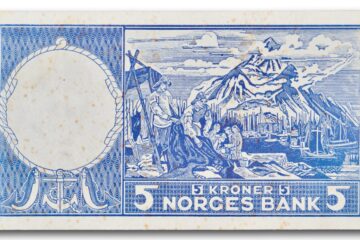In 1907, the Norwegian Finance Ministry constituted a committee for the purpose of preparing a design for 10 and 20 kroner gold coins in 1910. The committee’s members were Director of Museum of Decorative Arts and Design H.A. Grosch, professor L.B. Stenersen from Oslo University’s Coin Cabinet, artist Lars Utne, professor Bredo Morgenstierne and coin and medal engraver Ivar Throndsen. The 10 and 20 kroner gold coins were to be issued 5 years after Norway’s independence from Sweden, and it was important that the design supported Norwegian values and strengths. The design on the reverse was copied from a coin dated 1510-1522, struck under Archbishop Erik Valkendorf in Nidaros (Trondheim). Erik Valkendorf’s coin depicted King Olaf II Haraldsson (ca. 995-1030 AD), later known as Saint Olaf. The obverse of the gold 10 and 20 kroner wore King Haakon VII, the first king of Norway after more than 500 years of subordination to its neighbours Denmark and Sweden.
Before striking the new coins in 1910, the mint had to test the new design and have it approved. The striking started in 1909, and there were made an extremely small amount of test proof coins in copper that year. One can see a beautiful shine in the coins, and that is because they were gilded to look like gold coins. Shortly after their production, all test proof coins were destroyed by stamping an invalidating mark on both sides. This rendered the coins unusable but parts of the motifs are still visible. The result of this immediate destruction and subsequent lack of circulation is that the coins still have fresh and sharp details today. Could be that the aim for such rapid destruction was to keep these copper based coins away from circulation. What a scandal would have ensued had the mint put «fake» coins into the market! This theory is further supported by the fact that there are two test proof coins in gold dated 1909 that were not destroyed. These coins were given to the king, and have stayed in his family’s ownership since then.



